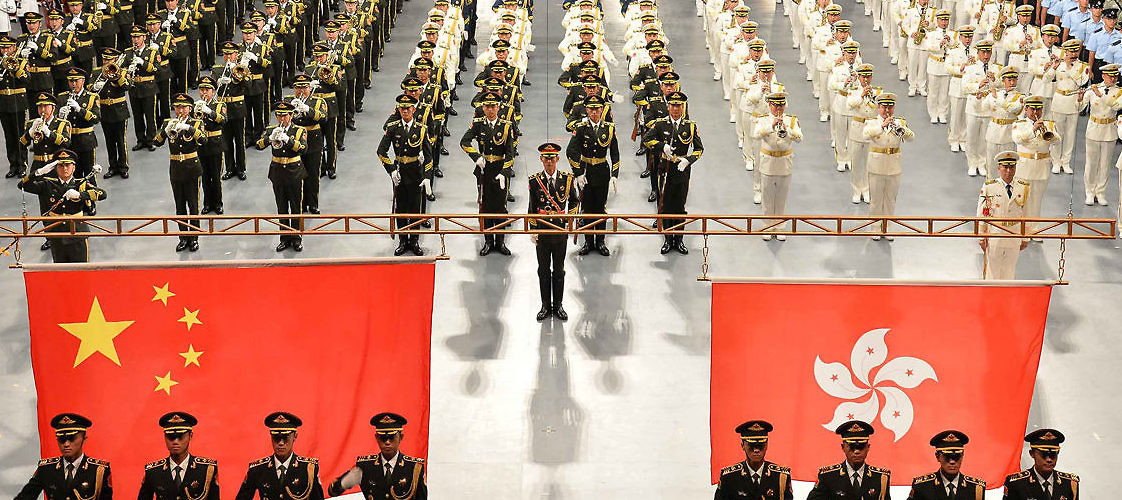Military bands rehearse for the 20th anniversary celebration of Hong Kong's return to mainland China. July 12, 2017 (Associated Press)
When Hong Kong was reunited with the People’s Republic of China in 1997, no one could tell how the “one country, two systems” (OCTS) framework would work. After two decades of experimentation, the Hong Kong Special Administrative Region has largely maintained its separate and distinct legal, political, and administrative systems; its market economy; its relatively free and pluralistic society; and its status as a global financial center; not to mention a way of life and culture very different from that of mainland China. But unexpected tensions now threaten this experiment.
The OCTS arrangement can be considered a unique form of contingent autonomy that depends upon the following conditions: First, given the huge asymmetry between the size and powers of the two parties, this arrangement rests on China’s self-imposed restraint. Second, to sustain the long-term stability of this arrangement, neither side should consistently harm the core interests of the other side. Third, even if one side may disrupt the equilibrium once in a while, they need to mend their fences before their relationship completely collapses. In other words, there should also be a modicum of trust between them. Last, the arrangement may be more stable if the smaller, weaker party still possesses resources to deter the more powerful party from imposing its priorities at will. Other factors such as the input of the international community may also shape the development of this relationship.
Some of these conditions remain stable, while others have changed. In Beijing’s eyes, the Occupy Movement, which broke out in late 2014 in response to conservative political reforms approved by China’s legislature, has severely challenged core interests such as sovereignty and national security. The rise of “localists” and pro-independence groups, though small in numbers, garnered around 400,000 votes in the 2016 Legislative Council election, putting Beijing on high alert. China has intervened more actively in Hong Kong’s governance since 2003, prompted immediately by the eruption of huge popular protests against the unpopular former chief executive Tung Chee-Hwa and national security legislation.
The ineffectiveness and unpopularity of the C.Y. Leung administration prompted Beijing to intervene even further. To tackle recent political troubles, Beijing has begun to devise new control mechanisms, including interpreting the Basic Law in advance of local courts against opposition legislators who swore allegiance to “the Hong Kong nation” during oath making. The criticism of the presence of foreign judges by Beijing’s advisers has inspired little confidence in the future of judicial independence and dampened the Hong Kong community’s confidence in OCTS.
In the near future, Beijing will be even more hands-on politically. Stability, not democracy, is paramount. Constitutional and legal levers utilized by Beijing will shape the general framework of Hong Kong’s government, legislature, and judiciary, while administrative supervision and oversight of Hong Kong’s legislation will cover the specifics. Central directives issued to the chief executive are not known publicly. But with the formalization and institutionalization of all the possible central powers that could be derived from the Basic Law, the scene has already been set for central intervention in Hong Kong’s domestic governance once Beijing believes its core interests are being threatened.
Economically, Beijing is integrating Hong Kong closely with the mainland. The latest Greater Bay Area plans to link the Pearl River Delta, Hong Kong, and Macao are being spearheaded by Beijing, not Hong Kong. Meanwhile, the strengthening of Hong Kong’s role as China’s renminbi offshore center, along with the launch of the Shanghai–Hong Kong and Shenzhen–Hong Kong stock connections—not to mention the latest bond market connect—will not only enhance the city’s role as a global financial center, but also fully entrench Hong Kong in the Chinese economic order. The completion of infrastructure, such as the Hong Kong–Zhuhai–Macao bridge and the associated high-speed rail link, will expedite more cross-boundary flows.
Socially and culturally, Beijing seeks more discursive power and a higher degree of allegiance from the Hong Kong community. Promoting national education, Chinese culture, and public acceptance of Beijing’s understanding of the Basic Law are priorities. The construction of the Palace Museum in the West Kowloon Cultural District, for example, ensures a dominant symbol of Chinese culture in a cosmopolitan area.
Newly appointed Chief Executive Carrie Lam has to address strong popular demands for housing, health care, retirement protection, civic engagement, democracy, and reconciliation in a politically divided community. Simultaneously, she must cope with growing expectations from Beijing for legislation on national security, the promotion of national education and identity, and forceful action against political challenges to central authority.
Hong Kong’s contingent autonomy is inherently unstable because it rests on the mutual trust and restraint of both sides. Keeping a delicate equilibrium demands the highest degree of political wisdom, flexibility, and patience from all parties. But to the extent that Hong Kong can sustain its competitiveness, political stability, and distinctive institutions (especially the rule of law and freedoms) while capitalizing on its international connections, there is no reason to believe that this historically unprecedented system will not work, albeit precariously. After all, since 1997 OCTS has defied the most pessimistic scenarios predicted two decades ago.
Peter T.Y. Cheung is Associate Professor of Politics and Public Administration at the University of Hong Kong. This article was originally published on East Asia Forum.





